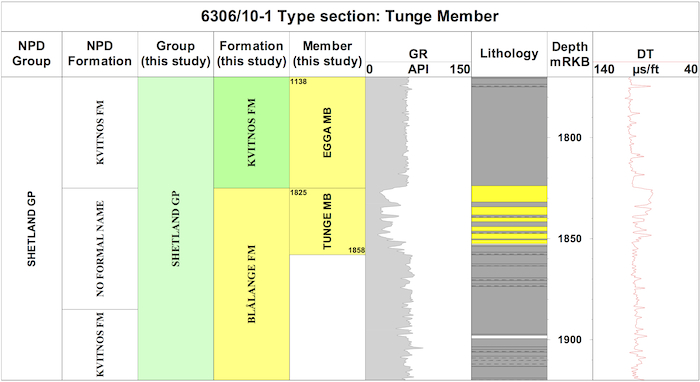 |
|
 |
|
updated to follow: Stratigraphic Guide to the Cromer Knoll, Shetland and Chalk Groups of the North Sea and Norwegian Sea. Felix M. Gradstein & Colin C. Waters (editors), Mike Charnock, Dirk Munsterman, Michelle Hollerbach, Harald Brunstad, Øyvind Hammer & Luis Vergara (contributors). Newsletter on Stratigraphy, vol 49/1 pp71-280, 2016
Shetland Group, Blålange Formation
English/ Norwegian and any previous names: In the type well 6306/10-1 the Tunge Member is noted on the NPD fact pages as a unit without formal name within the Kvitnos Formation. The operator Norske Shell referred to the unit informally as a 'Senonian sandstone unit'.
Derivatio nominis: The name Tunge is derived from the Norwegian for the common sole fish species Solea solea. The fish is usually found in numbers in the North Sea and northwards to Trondheimsfjorden, living on muddy bottoms from the littoral zone down to 150m depth and having a habit of migrating upwards through the water mass at night.
The Tunge Member consists of interbedded sandstones, mudstones and siltstones.
The sandstones are white - light grey to green, very fine to fine grained, with clear to translucent quartz grains, sub-angular, moderate to well sorted, firm to very hard, generally weakly cemented or occasionally with calcareous cement, abundant glauconite and with poor visual porosity.
The mudstones are light grey to dark greenish grey, moderately soft to firm, blocky to sub-blocky, non-calcareous and slightly micaceous.
The siltstones are medium dark grey, firm to moderately hard, blocky, micromicaceous and non-calcareous.
The Tunge Member varies in thickness from 10 m to 33 m.
The Tunge Member is developed on the eastern margin of the Møre Basin in quadrants 6205, 6305 and 6306 in the Rås Basin and Slørebotn sub-basin around the Gossen High. It is presumably sourced from the Norwegian mainland to the east or locally from structural highs in the area. Its thickest development is in the type well 6306/10-1.
Reference well 6305/12-1: Three sidewall cores (Hydro preparations) are available at 2608 m, 2632 m and 2646 m at the NPD covering the unit, upper and lower boundaries of the member.
Reference well 6305/12-1:
no cores were taken in this member.
WGS84 coordinates: N 63°09'26.32", E 06°19'41.45"
UTM coordinates: 7006088.05 N 365416.35 E
UTM zone: 32
Drilling operator name: A/S Norske Shell
Completion date: 17.12.1990
Status: P & A
Interval of type section (m) & thickness in type well:
1858 m - 1825 m, 33 m thickness.

WGS84 coordinates: N 63°01'25.73", E 05°47'23.94"
UTM coordinates: 6991476.94 N 641178.97 E
UTM zone: 31
Drilling operator name: Norsk Hydro Produksjon AS
Completion date: 18.09.1991
Status: P & A
Interval of reference section (m) & thickness in reference well:
2642 m - 2616 m, 26 m thickness.
In the type well 6306/10-1, the top of the Tunge Member is taken at a downward change from Kvitnos mudstones with minor limestone stringers to interbedded sandstones and mudstones. The change is sharp and the upper boundary is defined by a marked decrease in gamma-ray values and increase in sonic velocity. There is also an associated pronounced negative separation on neutron porosity and density logs in response to rapid termination of sandstones.
The base of the Tunge Member is characterised by a transitional change from sandstones and interbedded mudstones to more uniform mudstones of the underlying Blålange Formation. In the type well 6306/10-1, this boundary is defined at 1858mD RKB by a downward increase in gamma-ray values, and decrease in density logs representing the deepest thin sandstone beds. The decrease in sonic velocity and positive separation between neutron porosity and density logs is slightly higher in the section at 1851.5mMD, and represents the base of the sand-rich interval.
The Tunge Member is a time equivalent of the Lysing Member of the Halten-Dønna Terrace area and therefore part of the K80 sequence of Vergara et al. (2001), K60 sequence of Færseth and Lien (2002) and Lien (2005) and K72 sequence of Fugelli and Olsen (2005a).
There is limited detailed published data on the depositional setting of the Tunge Member. Vergara et al. (2001) in their regional seismic mapping study of the Norwegian Sea included these sandstones within their K80 sequence, in an area of the eastern Møre margin forming part of a slope apron system. This was characterised by sand-prone slope fans derived from an easterly, up-dip source area on the Frøya High or possibly as locally derived slumped debris flow units from the Gossa High and other local emergent structures (see their figure 10). In terms of the benthic foraminiferal biofacies, both the type and reference wells are characterised by low diversity deep water agglutinated foraminifera (DWAF), primarily Rhabdammina-Haplophragmoides spp. and pyritised microfossils that is consistent with a depositonal setting on a paleo-slope and suggest dysoxic bottom conditions. The marine microplankton is characterised by high diversities (22 - 26 species/sample) suggesting an open marine, normal salinity setting also.
Fugelli, E. and Olsen T. R. 2005a. Screening for deep-marine reservoirs in frontier basins: Part 1 - Examples from offshore mid- Norway. AAPG Bulletin 89(7):853-882.
Lien, T. 2005. From rifting to drifting: effects on the development of deep-water hydrocarbon reservoirs in a passive margin setting, Norwegian Sea. Norwegian Journal of Geology 85:319-332.
Vergara, L., Wreglesworth, I., Trayfoot, M., Richardsen, G. 2001. The distribution of Cretaceous
and Paleocene deep-water reservoirs in the Norwegian Sea basins.
Petroleum Geoscience 7:395-408.
| home | previous page |